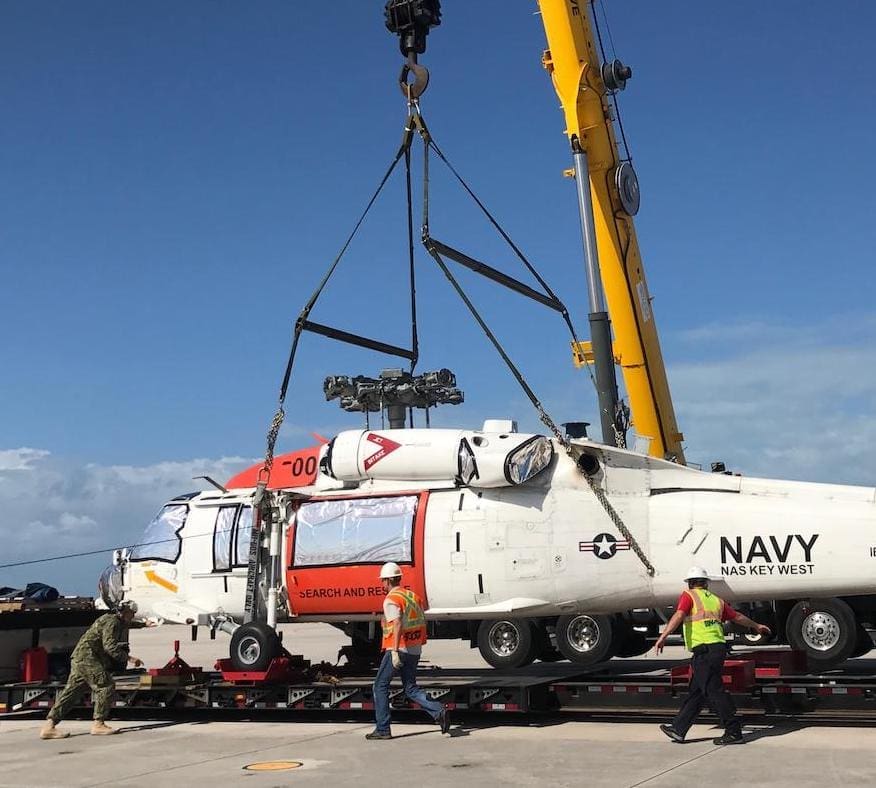As a specialist in heavy equipment transport, Next Exit has moved dozens of helicopters. That’s why a client who owns more than 30 helicopters contacted the logistics company when they needed a helicopter transported to Hawaii—and why Next Exit thought it would just be another move.
Helicopter moves require special equipment, drivers, and knowledge. Next Exit was ready for that since the company regularly moves helicopters for the military and private companies. Copters need to be transported by ground for several reasons. Sometimes while awaiting updates or repairs, they aren’t FAA approved. Sometimes they’re traveling to a big show, like the Heli-Expo. And sometimes, as in this case, they need to travel further than their fuel limits will allow.
Port Problems
This move seemed standard at first. An Airbus EC 135 needed to travel from California to Hawaii. The ships that Next Exit first contacted said they needed just 7 to 10 days notice. But later when they called to nail down the details, all the ships said they were no longer available—and that they wouldn’t have cargo space for 6 to 8 weeks. “The Department of Defense was doing a big move at the port,” said Next Exit’s president Chandler Magann. “And since their cargo takes priority over commercial cargo, they’d locked up most of the available space.”
But the helicopter had its own internal deadlines to meet. Delivery couldn’t wait 6 to 8 weeks. “So we leveraged all our connections,” said Magann. “We called everybody and anybody, but all resources had dried up. So we started asking questions: ‘What if we did this? What about this? Or this?’ Then we proposed a pretty creative idea and our resources at the port said, ‘Yeah, if you could actually pull that off, it could work.”
That idea, though unusual, was pretty simple. Next Exit had found a ship with some available room, but no equipment that could transport the helicopter from the truck to the ship. “So we decided to rent a trailer that could carry the helicopter and be rolled on and off the ship,” Magann said. “We didn’t have to use the crane or the port employees who work with the crane, which can cost up to $10,000 extra. Our solution actually simplified everything. The trailer was treated like an automobile, so the helicopter wasn’t a ‘helicopter’ anymore. It wasn’t even an oversized shipment.”
Trailer Trouble
Since space on the ship was tight, the trailer and helicopter needed to be less than 14 feet high when loaded. That was a problem. Not only is the Airbus EC 135 itself 10’7” high with the blades and tail cap off, but the trailer needed to be one that could safely carry transport helicopters, and the move was smack in the middle of Heli-Expo.
The largest helicopter exhibition in the world, Heli-Expo showcases helicopters from all over the world—which meant that all the suitable trailers in California were already reserved. Finally, Next Exit found a 48-foot double-drop Fontain trailer that was just was 22 inches high—but it wasn’t in California. It wasn’t even in the Pacific or Mountain Time zones. It was in Texas.
Blade Box Bother
Next Exit hired a contractor to drive the trailer from Texas to inland California, where the helicopter waited 415 miles away from its sailing port. “We got it there a week before it was scheduled to sail,” said Magann. “And a good thing, too.” The materials the client had ordered to wrap the helicopter were delayed and the original blade box was damaged. “We got quotes for repairs,” Magann said. “But we also realized the original box was too big and would push us beyond that 14-foot limit. We were trying to figure out what to do when the people at the California hanger said, ‘Hey, we found two blade boxes that fit perfectly. They belong to Airbus and actually need to be shipped back to Texas, so you could use them and then return them for us when you drive the trailer back. It worked out perfectly. It was like a miracle.”
For the 415-mile move across California, Next Exit needed to hire a helicopter mover expert, a driver who is specifically trained to transport copters safely from one place to another. “Luckily, we’ve moved enough helicopters to know when Heli-Expo takes place,” Magann said. “Of course we hadn’t known we’d need that specific trailer, but we did know we’d need a driver so he was already booked with us.” A company who hadn’t made a reservation ahead of time would never have found a driver, Magann said. “It’d be like calling a professional boat mover the day before Memorial Day and asking him to put your boat in the water that weekend. It wouldn’t happen.”
Hawaiian Hassle
The helicopter was transported across California to the port and onto the ship with no problem. Though the copter’s final destination was Maui, there was no way to ship directly to that island and stay on schedule given the limited available space on board ships, so Next Exit decided to ship it to Oahu, where it could be flown to Maui.
Luckily, Next Exit had built in days of wiggle time, because the ship was late getting to Oahu, and the carrier they’d lined up to transport the helicopter in Hawaii canceled, worried about the liability of transporting a multimillion-dollar helicopter. Next Exit found a qualified truck to transport the helicopter to the air operations area and then arranged for a crane to lift the copter off the trailer once it was in the area. The driver and helicopter arrived ahead of schedule, but the crane was running behind because of bad weather. Everyone involved agreed to leave the trailer and release the driver.
Of course, that meant the trailer and empty blade boxes—all of which needed to be returned to Texas—couldn’t sail back on the same ship they’d arrived on. “But there’s only about a 5% success rate with that anyway,” Magann said. “You can hardly ever unload and get right back on a ship. It’d be like getting off an airplane, grabbing your luggage in the terminal, unpacking and then repacking it, and trying to catch the same plane before it left.”
Shipping Success
Despite all the problems, Next Exit completed its mission-critical delivery ahead of schedule. “Everything that happened was a solvable and manageable problem, partly because we’re so proactive,” said Magann. “We under-promise and over-deliver. That’s why we could deal with port problems, a late ship, and an overly skittish Hawaiian carrier, and still make the delivery. The client was amazed we were able to deliver the helicopter ahead of time, especially since it was delivered to its final destination on March 6th—right in the middle of Heli-Expo.”
We’d like to do an amazing job for you, too. We’re proud to offer exceptional heavy equipment transport services and on-time critical freight delivery. At Next Exit, we earn the trust of our clients with efficiency, transparency, and security. In addition, we understand how to handle freight services for unusual, oversize, or overweight shipments and are certified to arrange the shipment of hazardous materials. To learn more about our services, call Next Exit Logistics at 866-624-2661 or contact us via email.




